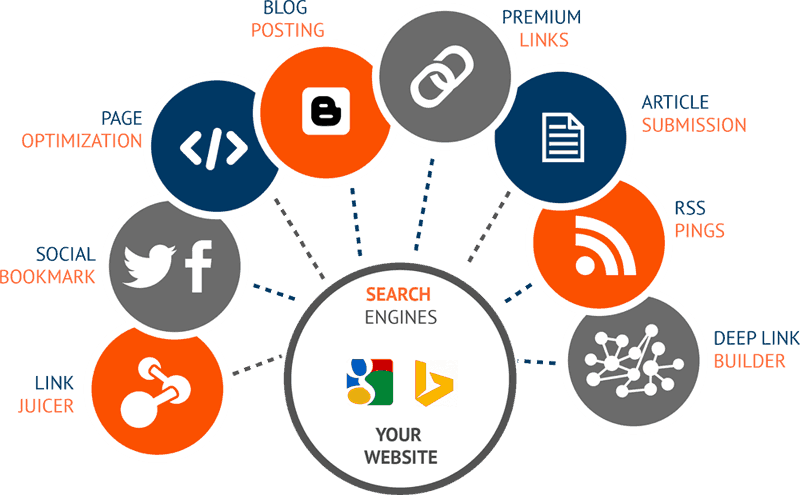- Home
- About Us
- Services
- Industries
- Portfolio
- Packages
- Our Clients
- Contact
Global SEO services refer to the practices and strategies aimed at optimizing a website to rank well in search engine results across multiple countries and regions worldwide.
The primary goal is to attract organic traffic from a global audience, considering the differences in language, culture, and search behavior in different
regions. Here are the key components and strategies involved in Global SEO services
Translation vs. Localization
Translation: Simply converting content from one language to another.
Localization: Adapting content to the local culture, including idioms, phrases, and context relevant to the target audience.
Implementation
URL Structure: Use subdirectories (e.g., example.com/fr/) or subdomains (e.g., fr.example.com) for different languages.
Hreflang Tags: Implement hreflang tags to indicate language and regional targeting to search engines, helping them serve the correct version of a page to users.
Geo-Targeting
Google Search Console: Set country targeting for each version of your site through Google Search Console.
Server Location: Consider hosting your website on servers located close to your target audience to improve site speed and user experience.
Mobile Friendliness
Mobile Friendliness: Ensure that your site is responsive and provides a good user experience on mobile devices, as mobile search behavior can vary globally.
Site Speed: Optimize your site for fast loading times, as speed is a crucial ranking factor and user experience aspect worldwide.
Keyword Variations: Identify keywords that users in different countries use, considering local language and dialect variations.
Local Search Volume: Use tools like Google Keyword Planner, Ahrefs, or SEMrush to find search volumes for target keywords in different regions.
Competitor Analysis: Analyze local competitors to understand their keyword strategies and identify opportunities.
Cultural Sensitivity: Create content that respects and reflects the cultural norms and preferences of different regions.
Local Content Creation: Develop unique content for each target market rather than just translating existing content. This includes blog posts, product descriptions, and marketing materials tailored to local interests.
Engagement: Encourage local user engagement through comments, reviews, and social media interactions.

Local Backlinks: Acquire backlinks from reputable local websites, blogs, and directories in your target regions.
Partnerships: Collaborate with local influencers, bloggers, and businesses to gain backlinks and increase brand visibility.
Local PR: Engage in public relations efforts in target countries to get media coverage and backlinks from local news outlets and industry publications.
Platform Preferences: Different regions have different preferred social media platforms. For example, WeChat in China, VK in Russia, and Facebook in many Western countries.
Localized Content: Share content that resonates with the local audience on their preferred platforms, in their native language.
Engagement: Actively engage with local users, respond to comments, and participate in regional trends and conversations.
Google My Business: Create and optimize Google My Business listings for each location if you have physical stores or offices.
Local Directories: Ensure your business is listed in relevant local directories and review sites.
NAP Consistency: Maintain consistent Name, Address, and Phone number (NAP) information across all local listings to improve local SEO.
Regional Performance Tracking: Use tools like Google Analytics to track performance by region, including traffic, user behavior, and conversions.
Custom Reports: Create custom reports to monitor the performance of each localized version of your site, helping to identify areas for improvement.
Adjust Strategies: Use data insights to refine and adjust your global SEO strategies based on what works best in each region.
Privacy Laws: Ensure compliance with local privacy laws and regulations, such as GDPR in Europe or CCPA in California.
Content Regulations: Be aware of and adhere to local content regulations and guidelines, which can vary significantly between countries.

Below are some of the technology tools and languages we are conversant in. As a top website
redesign agency,
we keep ourselves abreast of the latest technology developments.
HTML5
CSS3
JavaScript
Bootstrap4
Angular
PHP7
Codeigniter
Laravel
MySQL
Jquery
Finished Project
Happy Clients
Skilled Experts
Experience
Let us know what you need and we’ll handle the rest.


Highly customizable to fit unique business needs.
Free to use with affordable premium themes and modules.
Large community of developers and users offering support, modules, and plugins.
Suitable for small startups to large enterprises.